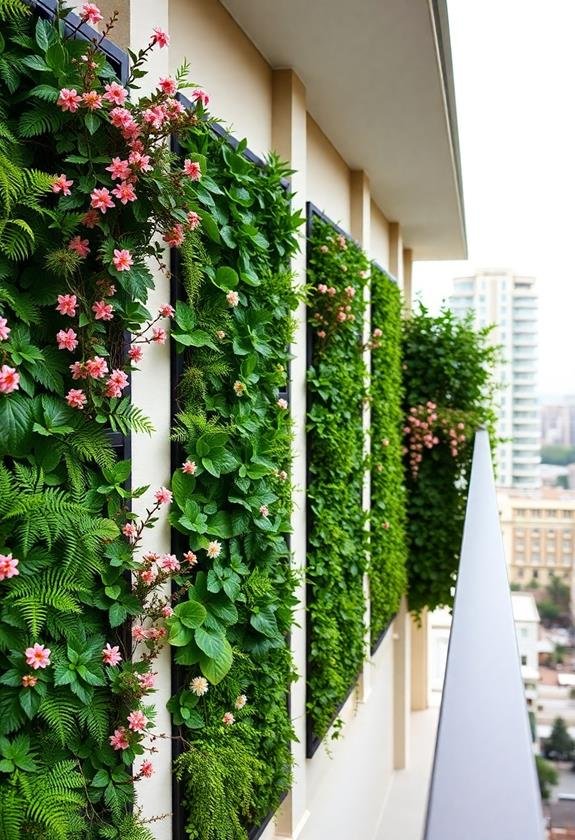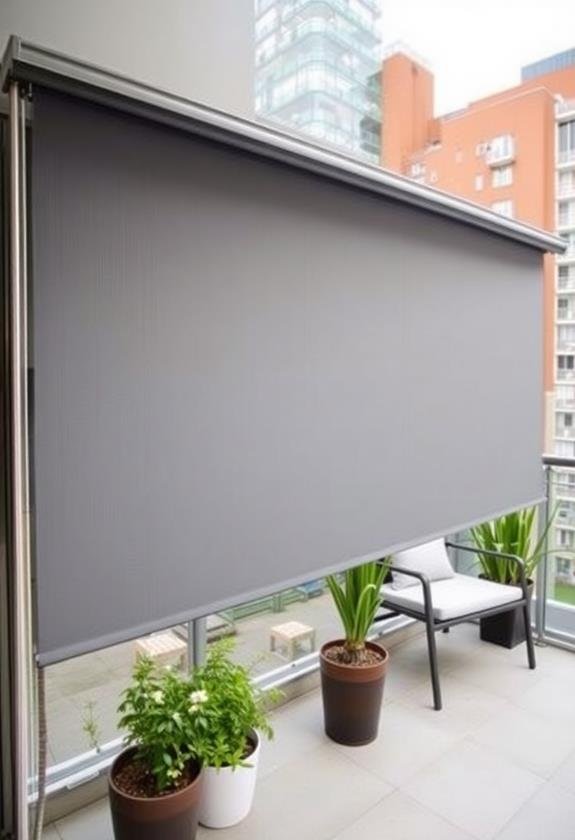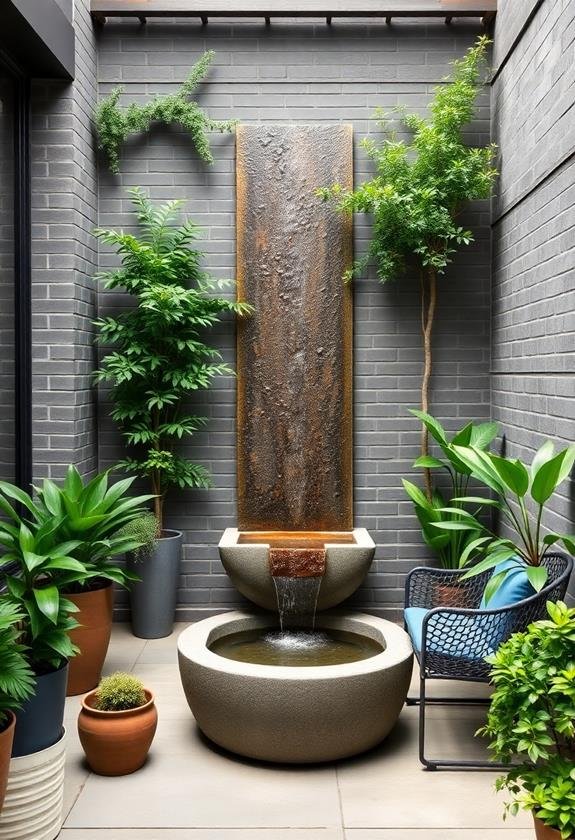Transform your compact outdoor space into a private oasis with a mix of natural and modern solutions. You’ll find instant privacy with sleek freestanding panels or retractable screens that tuck away when not needed. For a greener approach, try vertical gardens with climbing vines like jasmine or ivy, which create lush living walls within one growing season. Strategic container plant arrangements offer flexibility, while dual-purpose furniture pieces maximize your space – think slatted storage benches that provide seating and screening. Whether you prefer modern materials or natural greenery, there’s a stylish privacy solution that’ll perfectly suit your outdoor sanctuary.
Key Takeaways
- Vertical gardens and climbing vines create natural privacy screens while maximizing limited space through upward growth patterns.
- Retractable screens offer flexible privacy solutions that can be hidden when not needed, perfect for small patios and balconies.
- Strategic container plant arrangements provide movable privacy barriers while adding visual interest through layered heights and textures.
- Modern freestanding panels deliver instant privacy with sleek designs and weather-resistant materials in heights from 4-8 feet.
- Multi-functional furniture with integrated privacy features combines seating, storage, and screening to optimize compact outdoor spaces.
Natural Screening With Vertical Gardens

Living walls transform ordinary outdoor barriers into lush, green sanctuaries. When you’re looking to create privacy in your outdoor space, vertical gardens offer a stunning solution that’s both functional and eco-friendly.
I’ve found that climbing plants like jasmine, clematis, and ivy can turn a basic trellis into a gorgeous living screen within just one growing season. For smaller spaces, decorative garden fences can provide an elegant foundation for your vertical garden, offering both structure and aesthetics.
To create your own vertical garden, you’ll need:
- A sturdy support structure (trellis, wire mesh, or wooden panels)
- Well-draining potting soil
- Your choice of climbing plants
- Proper irrigation system
Start by selecting plants that match your climate and sunlight conditions. I learned the hard way that morning glories need full sun, while creeping fig thrives in partial shade!
Mount your support structure securely, ensuring it’s at least 6 inches away from any walls for proper air circulation. You can also incorporate pocket planters or hanging containers to add depth and variety to your living wall.
Don’t forget to establish a regular maintenance schedule – trust me, a quick weekly trim will keep your vertical garden looking polished and prevent it from becoming overgrown.
Modern Freestanding Privacy Panels
While natural screening takes time to mature, modern freestanding privacy panels offer instant seclusion with architectural flair. You’ll find these versatile panels in materials ranging from powder-coated aluminum to weather-resistant composites, and they’re remarkably easy to position wherever you need them most.
Similar to outdoor curtain trends, these panels often feature UV-resistant materials and versatile designs to enhance outdoor spaces. Their adaptability makes them suitable for various weather conditions and occasions.
Key Features to Evaluate:
- Height options (typically 4-8 feet)
- Weather resistance rating
- Installation method (freestanding vs. anchored)
- Pattern and design complexity
- Light filtration level
I’ve found that mixing panel styles creates the most interesting look – in my own courtyard, I’ve combined slatted bamboo panels with metal geometric screens, and the effect is stunning.
You’ll want to evaluate your existing outdoor décor when selecting patterns; modern laser-cut designs work beautifully with contemporary furniture, while traditional lattice patterns complement classic garden styles.
Pro tip: Look for panels with adjustable feet if you’re placing them on uneven surfaces.
And don’t forget about lighting – many panels now come with integrated LED options, which can transform your privacy screen into a gorgeous nighttime feature. You can even rotate the panels seasonally to create different spatial arrangements as your outdoor entertaining needs change.
Space-Saving Retractable Screens

Designed for maximum flexibility, retractable screens offer the perfect solution for homeowners who want privacy without permanent visual barriers.
You’ll love how these innovative screens roll up or fold away when you’re not using them, making them ideal for balconies, patios, and small outdoor spaces where every inch counts. Much like modular outdoor furniture, these screens provide versatile configurations to suit various occasions and space requirements.
When choosing a retractable screen, you’ve got several stylish options:
- Side-pull screens that extend horizontally, perfect for covering dining areas
- Vertical roll-down screens that work like window shades
- Accordion-style panels that fold neatly against the wall
I installed a motorized roll-down screen on my own deck last summer, and it’s been a game-changer for entertaining.
With just a push of a button, I can create an instant private oasis! You’ll find these screens in various materials, from weather-resistant mesh to semi-transparent fabrics that filter sunlight while maintaining airflow.
Pro tip: Look for screens with UV-resistant coating and rust-proof hardware – they’ll last much longer in outdoor conditions.
For easier maintenance, choose screens with removable panels that you can clean separately, and don’t forget to measure twice before ordering!
Strategic Container Plant Arrangements
Beautiful container plants offer a natural and adaptable privacy solution for your outdoor living spaces.
You’ll love how they create living walls that can be easily rearranged as your needs change, and I’ve found they’re perfect for renters who can’t install permanent structures.
To create an effective plant privacy screen, contemplate these strategic approaches:
- Layer different heights: Place tall bamboo or ornamental grasses in large containers at the back, medium-sized flowering shrubs in the middle, and trailing plants in front.
- Use mixed textures: Combine broad-leafed plants like cannas with feathery ferns for visual interest.
- Create year-round coverage: Mix evergreen plants with seasonal bloomers for continuous privacy.
Here’s a pro tip I learned the hard way: Always choose containers with wheels or plant caddies – you’ll thank me when it’s time to move them!
For maximum impact, group containers in odd numbers, and maintain at least three feet of depth in your arrangement.
Remember to contemplate your climate zone when selecting plants; I once made the mistake of choosing tropical plants for my Zone 5 patio, and let’s just say they didn’t make it past September!
Climbing Vine Privacy Solutions

Growing skyward offers another dimension for creating privacy in your outdoor sanctuary. When you’re working with limited space, climbing vines can transform ordinary fences, trellises, or pergolas into lush, living walls that provide both beauty and seclusion.
Choose from these tried-and-true climbing varieties:
- Clematis – I’ve found these gorgeous bloomers perfect for partial shade
- Boston Ivy – It’s a low-maintenance powerhouse that won’t damage brick
- Star Jasmine – You’ll love its intoxicating evening fragrance
- Virginia Creeper – Watch it turn brilliant red in fall
To get your climbers off to a strong start:
- Install sturdy supports before planting
- Space plants 18-24 inches apart
- Add rich, well-draining soil
- Provide guidance with twine or wire
Pro tip: Don’t make my rookie mistake of letting vines grow wild! You’ll want to maintain regular trimming schedules to keep them looking their best.
I learned this the hard way when my wisteria tried to eat my neighbor’s fence! Remember, most climbing vines reach maturity within 2-3 seasons, so you won’t have to wait long for that perfect private retreat.
Dual-Purpose Privacy Furniture Options
Many outdoor furniture pieces can now pull double duty as privacy screens while maximizing your space.
When I designed my own compact patio, I discovered clever furniture solutions that create intimate nooks without sacrificing style or functionality. You’ll love how these multi-tasking pieces transform your outdoor sanctuary.
Here are three smart dual-purpose privacy options that’ll revolutionize your space:
1. Slatted storage benches with tall backs – These beauties not only provide comfortable seating but also block sight lines while storing your gardening tools and cushions.
Position them strategically to shield views from neighboring properties.
2. Folding privacy screens with built-in planters – You can easily move these versatile pieces around your space, and they’re perfect for growing herbs or displaying trailing vines.
I’ve used mine to create a cozy dining nook that’s completely sheltered.
3. Modular sectional seating with high panels – These contemporary pieces let you configure your seating arrangement while blocking unwanted views.
The best part? You can rearrange them whenever you need a change, and many come with weather-resistant cushions that’ll last for seasons.
Frequently Asked Questions
What Permits Are Required for Installing Privacy Solutions in Rental Properties?
You’ll need to check with both your landlord and local municipality before installing any privacy solutions in your rental property.
Most temporary, non-permanent solutions like movable screens or potted plants don’t require permits. However, permanent structures like fences or built-in panels typically need written landlord approval and building permits.
I’d recommend starting with a friendly conversation with your property manager – they’re often open to reasonable modifications that don’t damage the property.
How Do Privacy Screens Affect Property Values in Residential Neighborhoods?
You’ll find that well-designed privacy screens can boost your property value, while poorly installed ones might do the opposite.
When you choose aesthetically pleasing materials like bamboo, cedar, or modern metal panels, you’re investing in curb appeal.
They’ll not only enhance your outdoor living space but also attract potential buyers who value privacy.
Just make sure they complement your home’s architecture and meet local HOA guidelines.
Can Privacy Solutions Withstand Extreme Weather Conditions Like Hurricanes or Heavy Snow?
You’ll want to choose weather-resistant materials for your privacy solutions – metal screens and sturdy bamboo can handle most conditions, but they’re not hurricane-proof.
For extreme weather areas, I’d recommend retractable or removable options you can store when storms approach.
If you’re dealing with heavy snow, angled panels or screens with proper drainage holes work best, and don’t forget to regularly check mounting hardware to confirm everything’s secure.
What Are the Annual Maintenance Costs for Different Types of Privacy Solutions?
While bare metal fences rust and wood panels rot, you’ll find annual maintenance costs vary considerably.
You’ll spend about $50-100 yearly on wood sealer for privacy fences, $20-30 for bamboo screen cleaning, and practically nothing for vinyl options.
If you’re using living privacy solutions like hedges, you’ll need to budget $100-200 annually for trimming and fertilizer.
Don’t forget periodic repairs – they’ll add roughly $50-150 depending on the material.
How Long Does It Typically Take to Install Various Privacy Screening Options?
You’ll find installation times vary greatly depending on your privacy choice.
Bamboo or reed screens can go up in just 1-2 hours, while lattice panels typically take 2-4 hours to mount properly.
If you’re thinking about a living wall, plan for 4-6 hours of initial setup.
Custom fence installations are the most time-intensive, usually requiring 1-2 full days with professional help.
For DIY solutions, add about 50% more time to these estimates.




